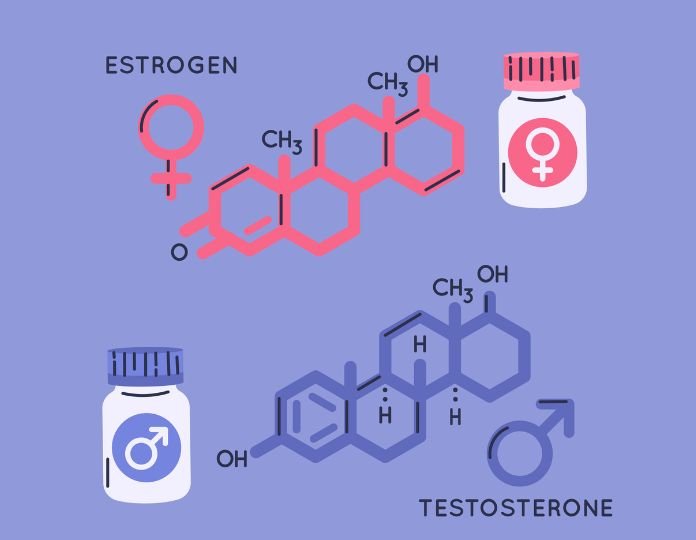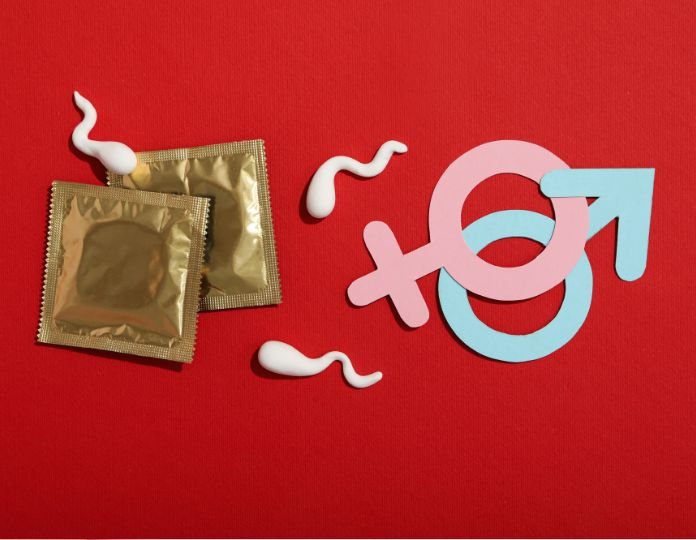Sexuality is an embedded aspect of who we are—shaping how we connect with others, perceive ourselves and navigate the world. Culture and society have their role, but the origins of sexuality go deeper, buried in the wiring of the brain, our hormones, and our DNA. The neurobiology of sexuality delves into this intriguing interaction, providing insights into how our neural and biological systems affect desire, orientation and identity—shedding light on the science of one of the most intricate dimensions of being human (Pfaus, 2009; Savic et al., 2005).
Read More: Psychedelics enhances Intimacy, Attraction and Sexual expression
Brain Structure and Sexual Differentiation
Sex differentiation of the brain begins early in life as a result of the influence of genetic and hormone factors. The sex chromosomes (XX or XY) induce a chain of events that lead to the development of sex-specific brain structures. For instance, size differences have been discovered to exist between the male and female brains in certain regions, like the hypothalamus, and the difference could be caused by sexual behaviour and sexual orientation differences (Swaab, 2007; Bao & Swaab, 2011).

Hormonal influence, particularly during periods of critical prenatal life, also decides brain differentiation. Testosterone, for instance, contributes to masculinizing the brain, whereas its deficiency results in feminization. The effect of these hormones is not solely accountable for sexual differentiation but is augmented by genetic components as well.
It has been noted that sex chromosomes contain genes that directly affect brain development independently of hormonal mediation (McCarthy & Arnold, 2011). Understanding these mechanisms forms the foundation of future research on how deviation from normal development can lead to variation in sexual orientation and identity in terms of interaction between biology and behaviour (Roselli, 2007).
Read More: Sexual Performance Anxiety: Symptoms, Causes, and Treatment
Hormonal Regulation of Sexual Behaviour
Hormones play a pivotal role in regulating sexual behaviour during development and adulthood. Organizational hormone effects, during foetal development and also at puberty, shape the sexual behaviour structure of the neurons. Activational effects, on the other hand, refer to the regulation of sexual behaviour based on varying concentrations of hormones in adulthood (Pfaff et al., 2008).

In women, the concentration of oestrogen and progesterone fluctuates during the menstrual cycle and influences sexual receptiveness and desire. In rodents, oestrogen has been shown to precondition the brain for sexual behaviour and that progesterone exposure afterwards enhances sexual receptiveness.
Testosterone is essential in men for sexual desire and sexual function. Testosterone stimulates brain regions like the medial preoptic area (MPOA) and paraventricular nucleus (PVN) in an effort to initiate sexual desire (Hull & Dominguez, 2007).
It works with neurotransmitters like dopamine and serotonin, which also have their roles in sexual behaviour as they operate in relation to hormones. Dopamine enhances sexual appetite and enjoyment, while serotonin represses sexual desire, so repeated use of SSRIs necessarily leads to sexual dysfunction (Pfaus, 2009; Clayton et al., 2018). These neurochemical and hormonal interactions demonstrate the sophisticated regulation of sexual behaviour, for which there has to be an entire understanding of sexual differences of experience.
Read More: The Psychology Behind Rebound Sex
Neural Circuits of Sexual Behaviour and Desire
Sexual behaviour and desire are regulated by an extensively interconnected set of brain structures. The hypothalamus, specifically the MPOA and PVN, plays a role in the initiation of sexual behaviour. Emotional and sensory information is analyzed by the amygdala, whereas the nucleus accumbens and ventral tegmental area (VTA) analyze the rewarding aspect of sex (Georgiadis & Kringelbach, 2012).

Dopaminergic circuits, i.e., VTA projecting to the nucleus accumbens, have a significant function in sexual reward and motivation. Activation of these pathways augments sexual desire and consolidates sexual behaviour. Serotonergic systems, by contrast, may inhibit sexual function, providing a counterbalance to the excitatory effect of dopamine (Hull & Dominguez, 2007).
Functional imaging studies have shown that individuals exhibit varying levels of neural activation when shown sexual stimuli. For instance, some individuals have increased activity within reward-related areas of the brain when shown sexual stimuli, and the activity relates to increased sexual desire and sexual behaviour (Walter et al., 2008). Understanding these brain circuits gives us a glimpse of the neurobiological basis of sexual desire and possible mechanisms of sexual dysfunctions, paving the way for specific therapeutic measures.
Read More: Understanding Sexual Desires in Teenagers
Neurobiology of Sexual Orientation and Identity
Sexual orientation and gender identity develop from a complex combination of genetic, hormonal, and environmental factors. Although earlier theories indicated one “gay gene,” recent studies indicate that numerous genetic factors, each with a small effect, account for same-sex sexual behaviour (Ganna et al., 2019). A neuroanatomical study has revealed structural differences in specific parts of the brain between homosexuals and heterosexuals.

For example, variations in corpus callosum and hypothalamic activity and volume have been described, pointing to a neurological basis for sexual orientation (Savic & Lindström, 2008). Gender identity, especially among transgenders, has also been associated with brain function and structure. Transgender brain patterns have been revealed to be more of their self-perceived gender than their sex at birth, again supporting the involvement of neurobiology in gender identity formation (Guillamon et al., 2016).
These remarks highlight that sexual orientation and gender identity are not simply choices but partly rooted in our biology and decided by a complex interplay of neural, hormonal, genetic and environmental factors.
Read More: Gender Sensitivity in Mental Health Practice
Sexual Behaviour and the Social Brain
Human sexuality is driven not just by biological necessity, but also by social and environmental factors. The “social brain,” which includes sections such as the prefrontal cortex, amygdala, and mirror neuron networks, governs our ability to empathize, understand social situations, and interact with people, all of which underpin sexual behaviour (Frith & Frith, 2007).

Sexual stimuli have been shown to activate not only reward-related brain regions but also social-processing brain regions, implying that sexual behaviour is influenced by both social environment and emotional states. For example, the presence of a trustworthy partner might increase sexual arousal, whereas social pressures can reduce sexual desire (Miller et al., 2019).
In addition, cultural expectations and individual experiences influence our sexual behaviours and orientations. Social experience in certain situations can be capable of shaping neural responses to sex-related stimuli, which suggests that sexual pathways in the brain are plastic and responsive to social situations (Georgiadis & Kringelbach, 2012). Keeping in mind the social brain function in sexual behaviour emphasizes the need to consider environmental and biological aspects when addressing human sexuality concerns.
Read More: How is Sex Addiction Treated ?
Neurobiological Disorders Affecting Sexual Function
Sexual dysfunctions are most typically caused by disruptions in the neuroendocrine processes that control sexual behaviour. These disorders can be caused by either psychological or biological reasons; however, the latter are often disregarded. Major depressive disorder, for example, is usually associated with low libido. Depression tends to suppress sex drive, and brain imaging confirms less activity within key reward sites like the prefrontal cortex and ventral striatum.

SSRIs can add to this effect by increasing serotonin while dampening dopamine-driven sexual reward (Clayton et al., 2018; Kennedy & Rizvi, 2009). Likewise, conditions like Parkinson’s and multiple sclerosis can impair sexual function by damaging the neural and spinal circuits that control arousal (Bronner et al., 2014). Endocrine disorders, such as low testosterone in men or dysregulation of oestrogen in women, also erode desire and physiological potential for sex (Corona et al., 2009).
That is why sexual dysfunction should be assessed through a biopsychosocial lens— one that considers physical health, emotional well-being, and relationship dynamics—to create care that’s truly personalized and effective.
Read More: Sexual Stigma and its relation with Psychological Well-Being
Ethical, Social, and Future Directions
The neurobiology of sex is a robust discipline, but it is not without ethical concerns. Among them is “neurosexism”—the misapplication of neuroscience to support gender stereotypes. Hyperbole regarding brain differences between sexes without respect for plasticity and environmental influences has a tendency to reinforce outmoded binarisms (Fine, 2013). Scientific communication must therefore be sensitive and context-aware.

The lack of representation of women and gender-diverse groups in neuroscience is also responsible for an equity issue. Research that excludes these groups can end up producing results and interventions that are ineffective or biased for a high percentage of the population (Cahill & Aswad, 2015). More and more, there is a need for gender-inclusive methods that not only offer representation but also examine data by sex and gender.
In the future, neuroimaging and genomic advances have the thrilling potential for tailored sexual health interventions. Yet these must be paired with ethical safeguards. Concerns regarding data protection, informed consent, and potential exploitation of neurobiological data—especially in domains like gender identity—must be addressed systematically. Similarly, progress does not have to threaten to become pathologizing or normative.
To reach the full potential of this field, neurobiology must evolve in conjunction with open, critical social theories. When science values human dignity and diversity, it is no longer simply knowledge—it is a means for equity.
Read More: Can Meditation Transform Your Sex Life For The Better?
Intersectionality and Inclusive Research
Looking at the neurobiology of sex without intersectionality generates an incomplete vision. Individuals’ experiences of sex and sexuality are shaped by the intersecting forces of race, gender, sexual orientation, class, and neurodiversity. By way of illustration, autistic women and nonbinary people generally report particular difficulties of intimacy and identity that default research methods might miss or misinterpret (Mogavero & Lalanne, 2020).

Newer paradigms like neuro-queer feminism advocate for the deconstruction of normative assumptions within neuroscience and the legitimation of non-traditional forms of gender and sexuality. This perspective not only critiques reductionist binary models but positively advocates for the incorporation of neurodivergent voices in the formulation of questions science poses.
Acknowledging variability—instead of attempting to standardize behaviour—can create avenues for the exploration of how different brains experience intimacy, pleasure, and identity.
Inclusive research also needs to go beyond diversity among participants and include community-based approaches. Co-produced research, which engages with marginalized groups in co-designing studies, creates both ethical salience and validity. This democratisation of knowledge production ensures findings are grounded in lived experiences rather than external standards.
As neuroscience evolves, integrating intersectionality will be imperative. An inclusive science is not one that simply studies diversity—it respects it as being central to what it means to be human.
Read More: The Relationship Between The Empathy In Pedophilia And Sexual Offending Against Children
Conclusion
The neurobiology of sex is a complex science that weaves together biological, psychological, and social factors. Although significant progress has been made in understanding the brain’s role in sexual behaviour and sexual identity, attempts to untangle ethical problems, promote diverse research methods and make scientific advances beneficial for everyone continue. Embracing complexity and diversity in research will pave the way for a richer and more even-handed understanding of human sexuality.
FAQs
1. How does the brain affect human sexuality?
The brain’s architecture, hormone activity, and neurological networks all have an impact on sexual behaviour. The hypothalamus, amygdala, and reward system all play roles in regulating sexual desire, identity, and behaviour.
2. Are sexual orientation and gender identity biologically driven?
Sexual orientation and gender identity are determined by biology (genes, hormones, and brain anatomy) as well as environmental factors.
3. How do hormones influence sexual behaviour?
Sex hormones like testosterone, oestrogen, and progesterone play a role in sexual desire and functioning. They act on brain regions that drive motivation and reward, influencing behaviour from childhood to adulthood.
4. What is the relationship between sociocultural factors and neuroscience in sexuality?
The “social brain” combines social experience with biological responses. Culture, relationships, and environmental cues all influence how the brain processes sexual stimuli, demonstrating that sexuality is both biological and context-dependent.
5. Can neurological or mental illnesses impair sexual function?
Yes. Depression, Parkinson’s disease, and hormonal imbalances can all have an impact on sexual desire and performance. Drugs with neurochemical activity, such as SSRIs, can also alter sexual responses.
6. Why is inclusion crucial for neurobiological research on sexuality?
Inclusive research recognizes that race, gender, neurodiversity, and lived experience all influence sexuality. By embracing intersectionality and various voices, science becomes more accurate, ethical, and representative.
References +
Bao, A. M., & Swaab, D. F. (2011). Sexual differentiation of the human brain: Relation to gender identity, sexual orientation and neuropsychiatric disorders. Frontiers in Neuroendocrinology, 32(2), 214–226. https://doi.10.1016/j.yfrne.2011.02.007
Bronner, G., Elran, E., Golomb, J., Korczyn, A. D., & Golan, D. (2014). Female sexuality in Parkinson’s disease. Journal of Sexual Medicine, 11(6), 1513–1518. https://doi.10.1111/jsm.12506
Cahill, L., & Aswad, D. (2015). Sex influences on brain function: The importance of being inclusive. Neuropsychopharmacology, 40(1), 1–3. https://doi.10.1038/npp.2014.200
Clayton, A. H., Kingsberg, S. A., Goldstein, I., & Goldstein, S. W. (2018). Management of hypoactive sexual desire disorder in women: Clinical practice recommendations. Journal of Women’s Health, 27(4), 434–443. https://doi.10.1089/jwh.2017.6610
Corona, G., Wu, F. C., Forti, G., & Maggi, M. (2009). Testosterone and metabolic syndrome: A meta-analysis study. Journal of Sexual Medicine, 6(9), 2729–2738. https://doi.10.1111/j.1743-6109.2009.01484.x
Fine, C. (2013). Delusions of gender: How our minds, society, and neurosexism create difference. W. W. Norton & Company.
Frith, C. D., & Frith, U. (2007). Social cognition in humans. Current Biology, 17(16), R724– R732. https://10.1016/j.cub.2007.05.068
Ganna, A., et al. (2019). Large-scale GWAS reveals insights into the genetic architecture of same-sex sexual behaviour. Science, 365(6456), eaat7693. https://doi.10.1126/science.aat7693
Georgiadis, J. R., & Kringelbach, M. L. (2012). The human sexual response cycle: Brain imaging evidence linking sex to other pleasures. Progress in Neurobiology, 98(1), 49– 81. https://doi.10.1016/j.pneurobio.2012.05.004
Guillamon, A., Junqué, C., & Gómez-Gil, E. (2016). A review of the status of brain structure research in transsexualism. Archives of Sexual Behaviour, 45(7), 1615–1648. https://doi.10.1007/s10508-016-0768-5
Hull, E. M., & Dominguez, J. M. (2007). Sexual behaviour in male rodents. Hormones and Behaviour, 52(1), 45–55. https://doi.10.1016/j.yhbeh.2007.03.030
Kennedy, S. H., & Rizvi, S. (2009). Sexual dysfunction, depression, and the impact of antidepressants. Journal of Clinical Psychopharmacology, 29(2), 157–164. https://doi.10.1097/JCP.0b013e31819c76e9
McCarthy, M. M., & Arnold, A. P. (2011). Reframing sexual differentiation of the brain. Nature Neuroscience, 14(6), 677–683. https://doi.10.1038/nn.2834
Miller, M. A., Donovan, C. L., Bennett, C. B., & Feldman, J. B. (2019). Partner presence and oxytocin modulation of sexual arousal in women. Hormones and Behaviour, 114, 104538. https://doi.10.1016/j.yhbeh.2019.06.002
Mogavero, M. C., & Lalanne, L. (2020). Neurodiversity and gender: Examining the neurobiology of diverse identities. Frontiers in Neuroscience, 14, 587226. https://doi.10.3389/fnins.2020.587226
Pfaff, D. W., Kow, L. M., & Loose, M. D. (2008). Hormonal control of sex behaviour in rodents. Archives of Sexual Behaviour, 37(1), 27–35. https://doi.org/10.1007/s10508- 007-9270-8
Pfaus, J. G. (2009). Pathways of sexual desire. Journal of Sexual Medicine, 6(6), 1506–1533. https://doi.org/10.1111/j.1743-6109.2009.01309.x
Roselli, C. E. (2007). Neurobiology of gender identity and sexual orientation. Journal of Neuroendocrinology, 19(6), 412–418. https://doi.org/10.1111/j.1365- 2826.2007.01556.x
Savic, I., & Lindström, P. (2008). PET and MRI show differences in cerebral asymmetry and functional connectivity between homo- and heterosexual subjects. Proceedings of the National Academy of Sciences, 105(27), 9403–9408. https://doi.org/10.1073/pnas.0801566105
Savic, I., Garcia-Falgueras, A., & Swaab, D. F. (2005). Sexual differentiation of the human brain in relation to gender identity and sexual orientation. Progress in Brain Research, 186, 41–61. https://doi.org/10.1016/B978-0-444-63904-4.00004-5
Swaab, D. F. (2007). Sexual differentiation of the human brain: Relevance for gender identity, transsexualism and sexual orientation. Gynecological Endocrinology, 23(4), 207–212. https://doi.org/10.1080/09513590701259514
Walter, M., Bermpohl, F., Mouras, H., Schiltz, K., Tempelmann, C., Rotte, M., & Northoff, G. (2008). Distinguishing specific sexual and general emotional effects in fMRI subcortical and cortical arousal during erotic picture viewing. NeuroImage, 40(4), 1482–1494. https://doi.org/10.1016/j.neuroimage.2007.12.026













Leave feedback about this